Unlocking Electrical Secrets AC Current Measurement with a Multimeter
Ever wondered about the invisible force powering your devices? It's alternating current (AC), the lifeblood of our electrical world. Understanding how to quantify this electrical flow is crucial, whether you're a seasoned electrician or a curious DIY enthusiast. This guide will illuminate the process of measuring AC current with a multimeter, empowering you to explore the electrical landscape with confidence.
Measuring AC current is a fundamental skill in electrical work, offering insights into circuit behavior and appliance functionality. From diagnosing faulty wiring to ensuring optimal performance of electrical systems, the ability to determine AC current is essential. This article will delve into the intricacies of using a multimeter for this purpose, providing a comprehensive guide from basic principles to advanced techniques.
The concept of measuring electrical current dates back to the early days of electrical experimentation. Early scientists and engineers developed instruments to quantify the flow of charge, paving the way for modern multimeters. These versatile devices have evolved over time, incorporating advanced features and functionalities while retaining their core purpose of measuring electrical parameters like current, voltage, and resistance.
Accurately determining AC current is vital for various reasons. It allows technicians to identify overloaded circuits, detect ground faults, and troubleshoot malfunctioning appliances. In industrial settings, measuring AC current enables efficient power management, preventing equipment damage and optimizing energy consumption.
Before diving into the practical aspects, let's clarify the concept of AC current. Unlike direct current (DC), which flows consistently in one direction, AC periodically reverses its direction. This oscillation is characterized by its frequency, typically measured in Hertz (Hz). The standard frequency for household AC in many parts of the world is 50 or 60 Hz.
To measure AC current using a multimeter, select the AC current setting (usually denoted by an "A" with a wavy line above it). Connect the multimeter in series with the circuit, ensuring power is off before making connections. Turn the power back on, and the multimeter will display the AC current flowing through the circuit.
Benefits of Measuring AC Current:
1. Troubleshooting Electrical Issues: Identifying the source of electrical problems becomes significantly easier with accurate current readings. For example, a low current reading might indicate a faulty component, while a high current reading could point to an overloaded circuit.
2. Ensuring Appliance Efficiency: Monitoring the AC current drawn by appliances allows you to identify energy hogs and optimize energy consumption. For instance, if your air conditioner is drawing excessively high current, it could indicate a need for maintenance or replacement.
3. Preventing Electrical Hazards: Detecting overloaded circuits or ground faults through current measurements helps prevent potential fire hazards and electrical shocks. This is especially crucial in older homes with outdated wiring.
Step-by-Step Guide:
1. Turn off the power to the circuit.
2. Select the AC current setting on your multimeter.
3. Connect the test leads in series with the circuit.
4. Turn the power back on.
5. Observe the current reading on the multimeter display.
Best Practices:
1. Always ensure the multimeter is set to the correct range before taking measurements.
2. Double-check the connections to avoid short circuits.
3. Never touch exposed wires while taking measurements.
4. Use appropriate personal protective equipment (PPE) such as safety gloves and eye protection.
5. De-energize the circuit before making any changes to the wiring.
Advantages and Disadvantages of Using a Multimeter for AC Current Measurement
Advantages: Relatively inexpensive, portable, versatile, can measure other electrical parameters.
Disadvantages: Can be damaged by incorrect usage, requires direct connection to the circuit, limited accuracy compared to specialized instruments.
Frequently Asked Questions:
1. What is AC current? AC current is an electrical current that periodically reverses its direction.
2. Why is it important to measure AC current? Measuring AC current is essential for troubleshooting electrical issues, ensuring appliance efficiency, and preventing electrical hazards.
3. How do I connect a multimeter to measure AC current? Connect the multimeter in series with the circuit.
4. What precautions should I take when measuring AC current? Always turn off the power to the circuit before making connections, and use appropriate PPE.
5. What is the difference between AC and DC current? AC current reverses direction periodically, while DC current flows consistently in one direction.
6. What are the common applications of AC current measurement? Troubleshooting appliances, diagnosing faulty wiring, optimizing energy consumption.
7. What are the limitations of using a multimeter for AC current measurement? Limited accuracy compared to specialized instruments, can be damaged by incorrect usage.
8. Where can I find more information about using a multimeter? Online resources, instructional videos, user manuals.
Tips and Tricks:
Use alligator clips for secure connections. Select the appropriate range for accurate readings. Check the multimeter's fuse before use.
In conclusion, understanding how to measure AC current with a multimeter is an invaluable skill for anyone working with electrical systems. It empowers you to diagnose problems, ensure safety, and optimize energy efficiency. From troubleshooting faulty appliances to monitoring circuit performance, the ability to quantify AC current provides essential insights into the electrical world around us. Mastering this skill allows you to tackle electrical tasks with confidence, ensuring the safe and efficient operation of your electrical devices and systems. Embrace the power of knowledge and explore the fascinating realm of electricity with your multimeter in hand. Remember to always prioritize safety and follow best practices for accurate and reliable measurements. Start exploring the electrical currents that power our world today!
From runway to screen the captivating journey of moon ga young
Decoding the hvac fan relay your guide to comfort control
Top 10 country and western singers a guide to the legends













